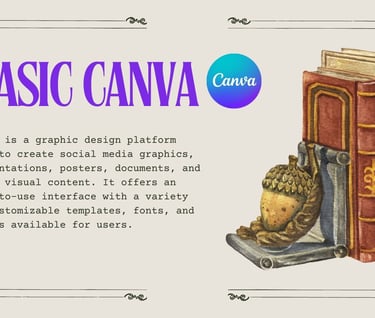

WHAT WHY AND HOW OF CANVA
WHAT IS CANVA
Canva is an online graphic design platform.
Launched in 2013, it is used to create visual content.
Offers a user-friendly, drag-and-drop interface.
Provides templates for presentations, social media, posters, videos, infographics, resumes, logos, and more.
Accessible via web browsers and mobile apps.
Free to use with optional premium upgrades (Canva Pro).
No professional design background needed.
WHY USE CANVA
1. Simplicity and Accessibility
Designed for beginners and non-designers.
No installation required; cloud-based platform.
Works on PC, tablet, or mobile phone.
2. Time-Saving Templates
Thousands of ready-made templates.
Saves time for businesses and individuals.
Templates cover marketing, education, events, personal projects.
3. All-in-One Design Tool
Combines photo editor, video maker, presentation creator.
Includes AI tools: Magic Write, Text to Image, Background Remover.
Offers design elements: icons, stock photos, animations, charts.
4. Branding and Consistency
Brand Kit lets users save logos, colors, and fonts.
Ensures brand consistency across platforms and teams.
Ideal for startups, SMEs, NGOs, educators.
5. Collaboration Features
Real-time team editing.
Shareable design links for review or approval.
Commenting system for feedback.
6. Cost-Effective
Free version offers plenty of features.
Canva Pro is affordable and adds advanced features.
Eliminates the need for costly software like Adobe Creative Suite.
7. Integration Capabilities
Integrates with tools like Google Drive, Dropbox, Meta, TikTok, HubSpot.
Publishes directly to social media and websites.
8. Empowerment Through Visuals
Empowers users to visually communicate ideas.
Supports storytelling, marketing, education, and activism.
Builds confidence in design even without prior experience.
HOW TO USE CANVA EFFECTIVELY
1. Set Up Your Account
Go to canva.com and sign up using Google, Facebook, or email.
Choose your role: student, teacher, personal, business.
2. Choose a Design Type
Select from suggested design categories: Instagram Post, Presentation, Poster, etc.
Custom size available for unique dimensions.
3. Pick a Template or Start Blank
Search for templates by keyword or category.
Customize a template or create a design from scratch.
4. Use the Editor Interface
Left panel: elements, uploads, text, apps.
Center canvas: drag and drop elements.
Top panel: adjust font, color, spacing, alignment, animations.
5. Add Your Content
Replace template text with your own.
Upload images or use Canva's stock photo library.
Insert shapes, icons, charts, videos, and audio if needed.
6. Use Tools and Features
Background remover (Pro).
Magic Write for AI content generation.
Brand Kit to maintain branding consistency.
Animation tools for interactive content.
Layers and grids to arrange elements.
7. Collaborate and Share
Invite team members via email or link.
Enable viewing, editing, or commenting access.
Add notes or comments for collaborative editing.
8. Download and Publish
Download in multiple formats: JPG, PNG, PDF, MP4, SVG (Pro).
Share via email, link, or social media.
Schedule posts directly using Canva’s Content Planner.
9. Learn and Improve
Use Canva Design School to access free courses.
Follow blogs, tutorials, and webinars for design tips.
Join Canva communities or social groups for peer learning.
10. Explore Advanced Uses
Create ebooks, planners, journals for digital products.
Design pitch decks, business cards, YouTube thumbnails.
Automate content creation using Bulk Create and AI tools.
Sell templates or designs on marketplaces like Etsy.
Learning
Empowering skills for digital entrepreneurs and growth.
click here
© 2025. All rights reserved.
